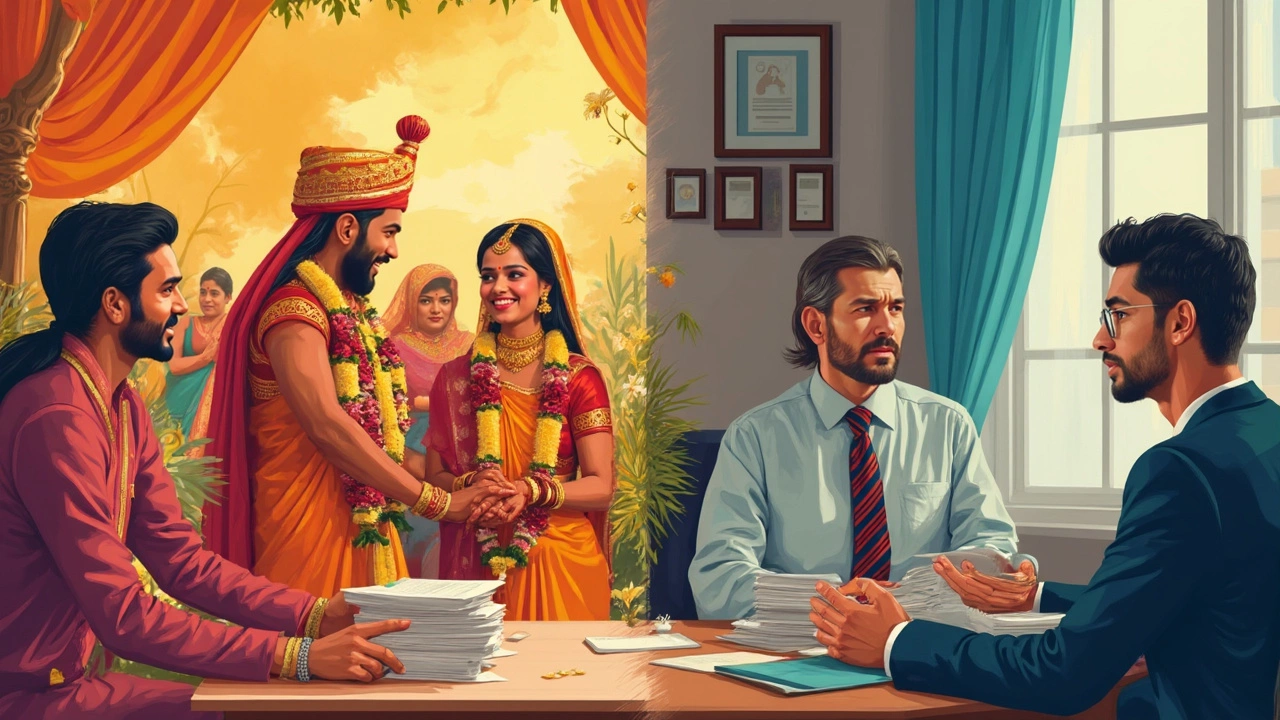Picture this: you married in a grand ceremony in India, maybe with a big baraat and lots of Bollywood dance numbers. Fast-forward a few years, and life’s drifted in ways you never expected. Maybe you’re now living in Chicago or New York, and the relationship isn’t working. The golden question pops up—can you actually get a divorce in the US if your marriage happened in India? It’s a surprisingly common crossroads for those who build a new life across continents.
Understanding Jurisdiction: Who Has the Right to Grant Your Divorce?
Let’s start with how US courts decide if they even have the power—or jurisdiction—to handle divorces for marriages performed overseas. Here’s the deal: In the US, the most important factor is where you and your spouse actually live, not where you got married. This is a relief for many Indian couples because you don’t have to return to India or navigate the Indian legal maze for a divorce.
In almost every US state, as long as you or your spouse meets state residency requirements, you can usually file for divorce locally, regardless of where the marriage ceremony took place. For example, in California, you need to have lived in the state for six months and in your current county for at least three months. Chicago asks for 90 days’ residency in Illinois. Rules differ by state, so check your local family court’s website—but it’s almost always residency that matters most, not origin of marriage.
Now, just because you can file in the US, doesn’t magically make things simple. If your spouse remains outside the US, say in Mumbai or Bengaluru, serving them divorce papers can be a challenge. US courts usually need proof that the other partner received proper notice, so you might need help from international legal services to reach them. The good news? The US generally recognizes valid marriages performed abroad (like your Indian wedding), and also gives its official backing to divorce judgments given by local US courts. That means, in legal terms, you can split up on home turf even if the wedding happened thousands of miles away.
One pro tip: if either you or your spouse currently live in India, figuring out which court—US or Indian—has the first and final say can get tricky. Double filing (in both the US and India) isn’t uncommon, but it can drag things out and hike up your lawyer bills. A US court order, though, usually carries significant weight.
The Process: Step-by-Step Guide to Divorcing in the US After an Indian Marriage
So, how does this all shake out day-to-day? Here’s what the step-by-step process looks like if you're trying to end an Indian marriage inside the US:
- Check residency requirements: Find out how long you (or your spouse) must live in your state before you’re allowed to file.
- Gather documents: You’ll usually need the official Indian marriage certificate (translated and notarized if it’s not in English), plus proof of identity, and any prenuptial agreements.
- File a divorce petition: Submit the paperwork to the local family court. You don’t need to mention that your marriage was in India—just that it’s officially registered and valid.
- Legal notice to spouse: If your spouse is in the US, they’re sent papers like any other case. If they’re in India or anywhere else overseas, courts often use special international mail or sometimes even work with the Indian consulate.
- Wait out mandatory periods: Many states have waiting periods (sometimes six months), even for uncontested divorces.
- Settlement or trial: If you and your spouse agree on splitting things like property, custody, and support, you can often avoid courtrooms. If not, you may need hearings or even a trial. US courts will split marital property according to American rules, not Indian laws.
- Final decree and paperwork: Once all issues are sorted, the local judge signs a divorce decree, making you officially divorced in the US.
Don’t forget: To remarry or settle legal issues back in India, you might need to register this US divorce judgment with Indian authorities. Sometimes, Indian courts require what's called an ‘exequatur’—recognition of a foreign divorce decree.
One more thing—you can file for either fault or no-fault divorces in the US. Most states have no-fault laws, meaning you can split because “irreconcilable differences” make your relationship unworkable. No need for accusations or drama unless kids or major money is involved.

Potential Hurdles: What Complicates International Divorces?
If the process sounds smooth, reality often throws curveballs. The biggest complication? Jurisdiction battles. If your spouse contests the US filing and starts their own case in India, you could wind up fighting battles in both countries. Indian courts don’t always recognize US divorce decrees, especially if they think they don’t match Indian laws or that the other partner didn’t get a fair chance to defend themselves.
Child custody is another minefield. US courts work in your child’s best interest and their decisions are made using American law, but that doesn’t always align with decisions by Indian courts. Sometimes, parents take kids back to India in the middle of a case—which complicates enforcement of custody orders. International parental abduction isn’t just soap opera drama; it happens more often than you'd guess. The Hague Convention on International Child Abduction can help resolve these disputes, but India isn’t a signatory, at least for now. So if you’ve got kids, brace yourself for possible cross-border tug-of-war.
Division of property is usually done following US laws, too. So, marital assets in the US (houses, cars, accounts) are divided by state law, even if your spouse is in India or your family gold is in Delhi. US courts generally can’t touch property solely in India, so you may need to file separate cases there. That’s a headache, especially if there are ancestral homes or investments overseas.
One oddity: Some Indian families expect formal written consent or letters from both spouses for a US divorce, which isn’t required by American law. You might face pressure from relatives to resolve things “back home,” but legally, your US divorce stands within the US legal system. Still, if you ever move back to India, you might have to reconcile US and Indian paperwork, especially when it comes to remarriage, passport changes, or child custody.
If you suspect your spouse won’t participate, remember: US courts can still grant what’s called a “default judgment,” even if the other person ignores the divorce notice, so long as legal service is properly attempted. That’s one less exit barrier.
Legal and Emotional Tips: Making It Easier to Divorce Across Borders
Think getting divorced sounds exhausting? You’re not wrong, especially with international layers to the salad. Here are some real-world tips to help you stay on the smart side of this maze:
- Hire an experienced attorney. Not just any family lawyer, but one who actually handles international divorces and gets the blend of Indian and US law. It’ll cost more but save you major headaches.
- Double-check your documents. Get your Indian marriage certificate officially translated and notarized if it isn’t in English. Keep copies safe—you’ll need them for everything from visa changes to any future Indian paperwork.
- Plan for Indian court recognition. If you ever think you’ll live in India again or own property there, talk to your lawyer about registering your US divorce with Indian courts. It’s called “recognition of foreign decree” and can smooth remarriage, property claims, or inheritance down the line.
- Think about children ahead of time. If there’s even the tiniest chance of custody battles, keep a record of your involvement as a parent. International custody fights can be brutal, and US court orders aren’t always easy to enforce in India.
- Consider mediation. Sure, TV dramas make trials look exciting, but most divorces—especially international ones—benefit from professional mediation. It’s cheaper, faster, and reduces cross-cultural misunderstandings, especially if you and your spouse are from different backgrounds or countries.
- Be mindful of timing. If you filed for divorce in the US, don’t automatically assume you can jump right into Indian proceedings if things drag out. Check with your lawyer for conflicts on which country’s court has priority.
On the personal side, it can be weird to process a breakup from an overseas marriage where family and friends are oceans away. Find support—whether through a therapist, close friends who get the immigrant experience, or online groups for the Indian diaspora. You’re not alone; tons of people navigate this same cultural puzzle every year.

Strange-but-True Scenarios: Stories from Real Couples
If you’re feeling isolated, you’re not the only one managing traditions, distance, and the US legal system. Like the couple from Hyderabad who married in India, moved to Texas, split up—and then spent months tracking down paperwork just to prove they were actually married. Or the software engineer in California who filed for divorce, served papers via the Indian consulate, and finally got his decree years before his spouse even showed up to contest.
Another quirky fact? Some Indian Americans find themselves in what’s called a "limping marriage": you’re considered divorced in the US, but still married in India—at least according to government paperwork. This happens if the foreign divorce isn’t recognized. Messy, right? That’s why experts say: if you want to remarry or inherit anything in India, don’t just stop with a US decree. File for recognition abroad, too.
And don’t believe every myth online. Some blogs insist you have to fly to India and live there six months to get a divorce—false, at least on the US side. As long as you meet local residency rules, American courts will handle your divorce, even if nobody in your family approves or your spouse stays silent abroad.
The rise of digital records helps. Many Indian districts now offer electronic certified marriage certificates, so if you lost yours in a move or it’s buried in a family trunk, you might get a new copy through official government portals. Saves a flight just to dig up one paper.
Some couples try to avoid the courts entirely by negotiating “mutual consent” divorces directly with each other, then registering it in both countries. This rarely works unless both sides are 100% on board. Otherwise, stick to the formal legal process and get good advice.
Last but not least, if you have permanent residency or a green card tied to the marriage, talk to an immigration expert before making any moves. Divorce can sometimes affect status—though US immigration generally recognizes a legitimate separation, as long as the marriage was honest.
You’re not breaking uncharted ground. Thousands each year go through the same overlap of love, law, and location—from arranged marriages to whirlwind romances that started in one country and ended in another. Just remember to get the paperwork right the first time—saves years of confusion and family drama down the line.


